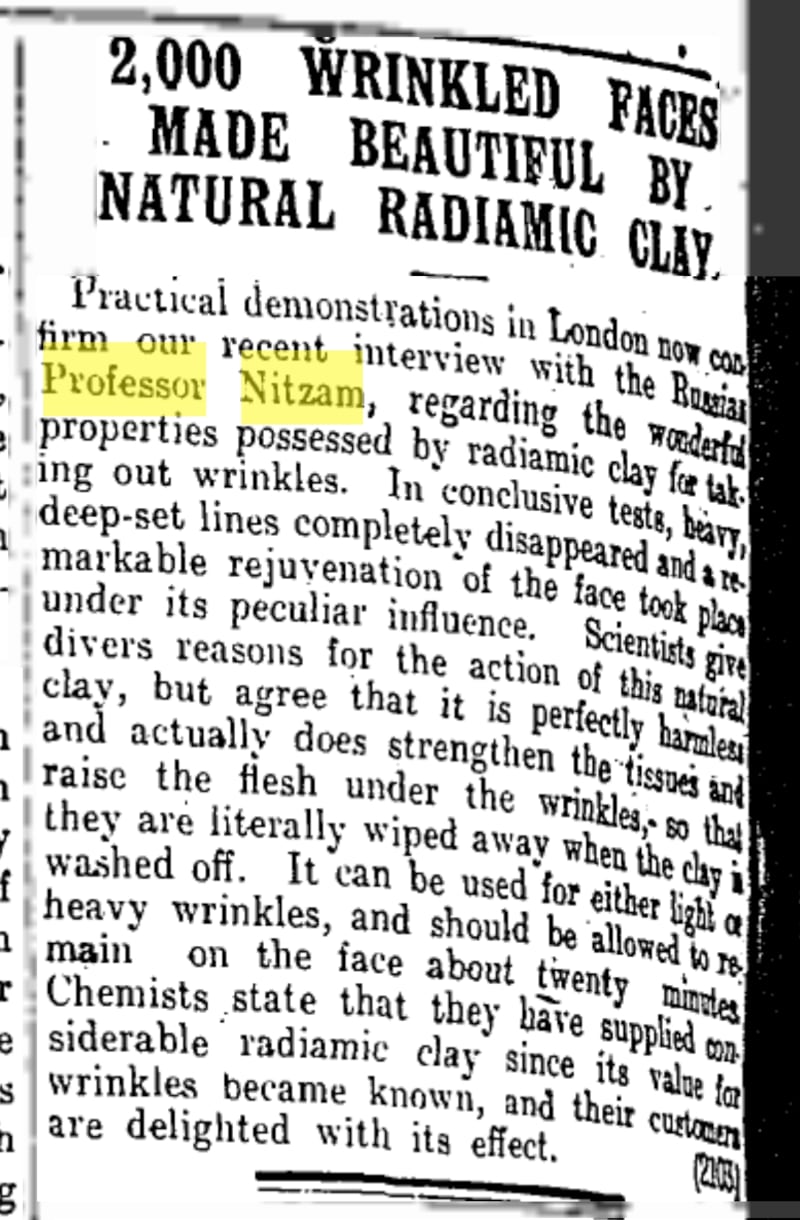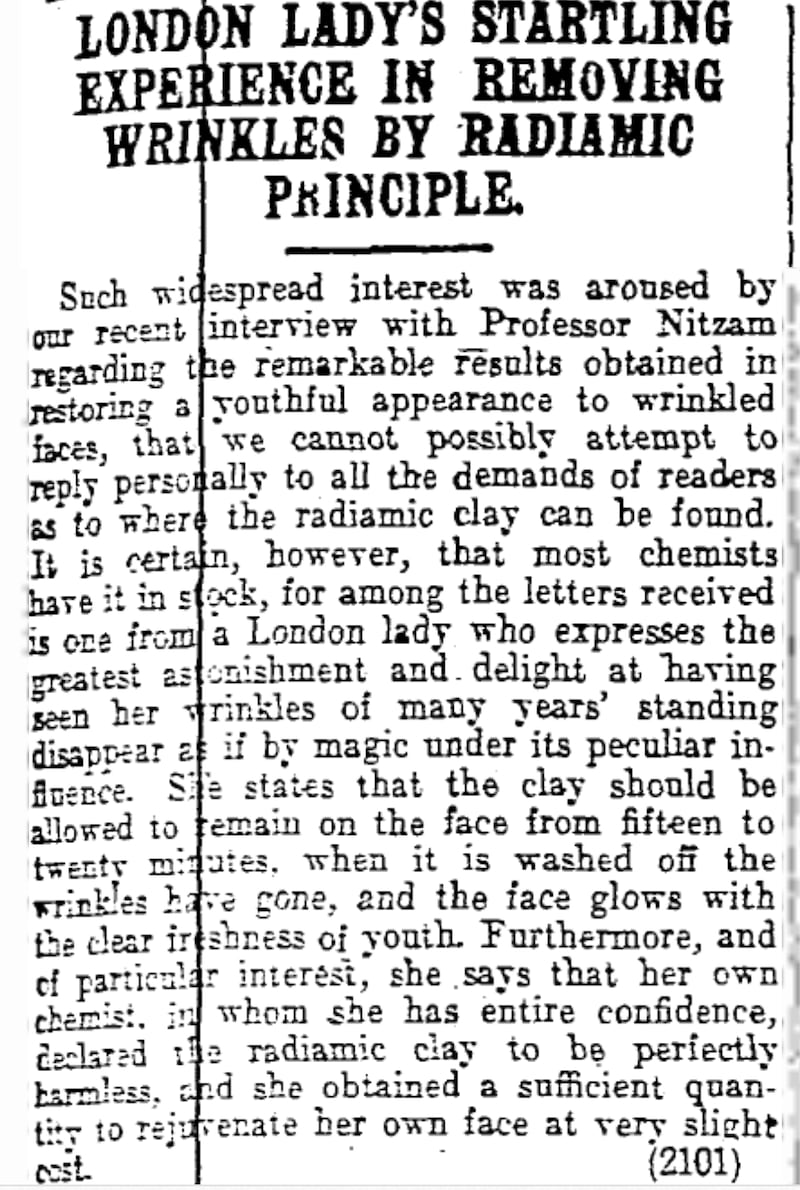On August 23rd, 1913, an interview appeared in The Irish Times about a development in the beauty and cosmetics industry. The headline was certainly eye-catching: “Wrinkles two inches long and one-eighth inch deep completely removed in 20 minutes”.
The wonder product? Radiamic clay. “It is not a miracle, although some people seem to think so,” the interviewee, Prof Nitzam, said. “The radiamic clay which we used is purely a product of nature and acts on the skin in a natural manner. Its application literally wipes away all signs of worry, trouble or ill health that have left their marks in the skin, giving back the clear elastic freshness of youth to the face. This effect is due to the peculiar natural properties of the clay, which strengthen the tissues and raise the flesh under the wrinkles, thus causing them to entirely disappear. The lighter lines are easily banished, but there is sometimes a tendency for the deepest wrinkles to reform. In such cases, one or two additional applications should be sufficient. The clay is perfectly harmless and its use requires no special skill.”
Apparently, Irish Times readers went wild. The following weekend, the newspaper returned to the story. “London lady’s startling experience in removing wrinkles by radiamic principle” the follow-up article was headlined. “Such widespread interest was aroused by our recent interview with Prof Nitzam regarding the remarkable results obtained in restoring a youthful appearance to wrinkled faces, that we cannot possibly attempt to reply personally to all the demands of readers as to where the radiamic clay can be found.”
The writer informed readers that most chemists had radiamic clay in stock. One of those letters was from “a London lady who expresses the greatest astonishment and delight at having seen her wrinkles of many years’ standing disappear as if by magic under its peculiar influence. She states that the clay should be allowed to remain on the face from 15 to 20 minutes, when it is washed off the wrinkles have gone, and the face glows under the freshness of youth”.

The following month, news landed in the newspaper about beauty demonstrations that appeared to confirm Nitzam’s assertions. The headline announced that 2,000 wrinkled faces were made beautiful by radiamic clay. “Practical demonstrations in London now confirm our recent interview with the Russian Prof Nitzam, regarding the wonderful properties possessed by radiamic clay for taking out wrinkles. In conclusive tests, heavy, deep-set lines completely disappeared and a remarkable rejuvenation of the face took place under its peculiar influence… Chemists state that they have supplied considerable radiamic clay since its value for wrinkles became known, and their customers are delighted with its effect.” It’s important to note that at this point, radiamic clay was appearing in the news section of the newspaper, as opposed to the more fashion and lifestyle-orientated pages.
That same month, an Irish Times reader, “Madame Arlington, of London, who recently read in these columns of the astonishing success of the radiamic clay in restoring a youthful appearance”, wrote to the newspaper detailing how her wrinkles had vanished in one application. “Now people think my face looks as young as that of my daughter, and often take us for sisters.” Hmm. Was this all a triumph of carefully placed stories, unmarked advertorials, or mysterious marketing?

There is very little information about what exactly radiamic clay was. Most contemporary references to “radiamic” refer to literal rocket fuel, so to unravel the mystery, we contacted Rachel Weingarten, a beauty historian specialising in early 20th century cosmetics and author of Hello Gorgeous! Beauty Products in America in the 1940s-60s. Weingarten is suspicious of the claims made regarding the product, which is one she hasn’t previously encountered.
“Before any type of organised cosmetics brands existed, many hucksters would create batches of products and peddle them. Some were innovators and came up with clever names, or at least catchy ones. Clay is a known skincare ingredient (though usually used for it’s more astringent properties, say for a blackhead mask), so the notion wasn’t new. Clay baths go back to ancient times. It’s entirely possible that this ingredient was simple river clay or even bentonite clay – a very common ingredient in skincare and masks – that was given a jazzed up name for marketing purposes.”
And what about how radiamic worryingly evokes radium? “I think it’s supposed to sound that way,” Weingarten says. “It could literally be about the timing. Bear in mind that those were the years that Marie and Pierre Curie were making headlines for discovering the radioactive elements polonium and radium. That was 1911, so it was a buzzword.”
So before you bemoan the dominance of beauty “influencers” in contemporary media, it’s worth remembering that they are standing on the shoulders of wrinkle-free, curious giants, and that looking back at 1913, it is genuinely difficult to identify what may be early “native advertising” or fake beauty news.




















